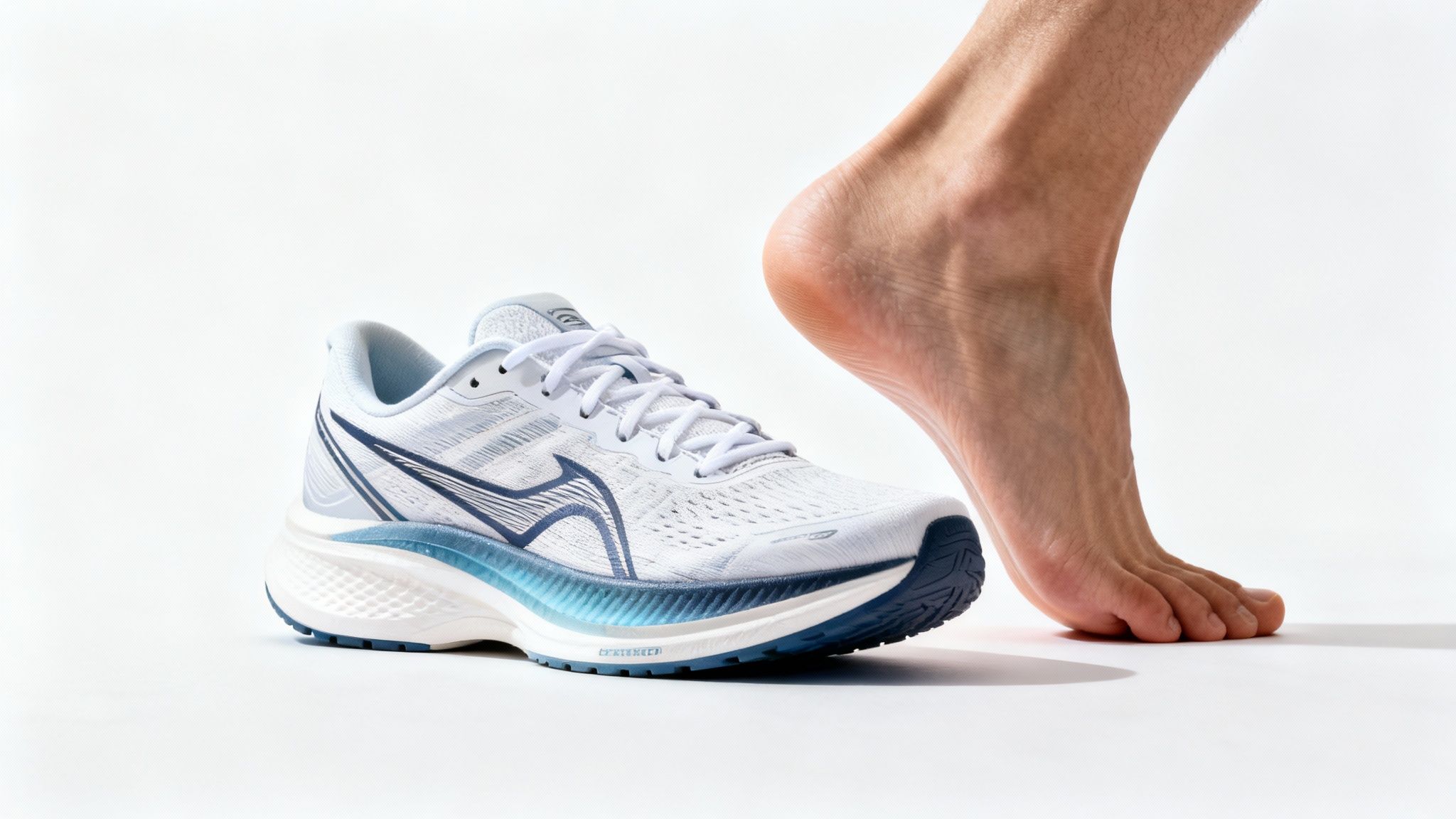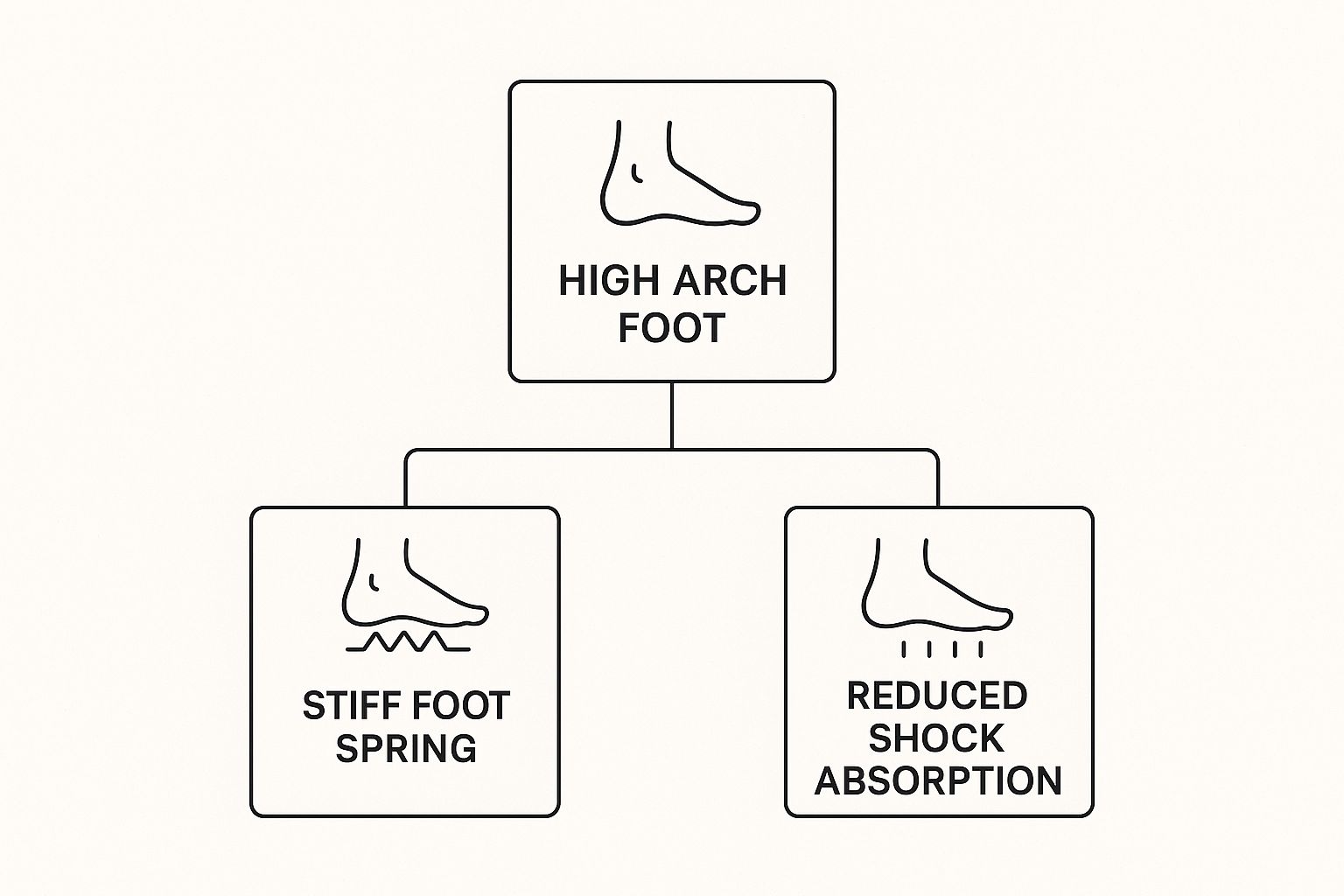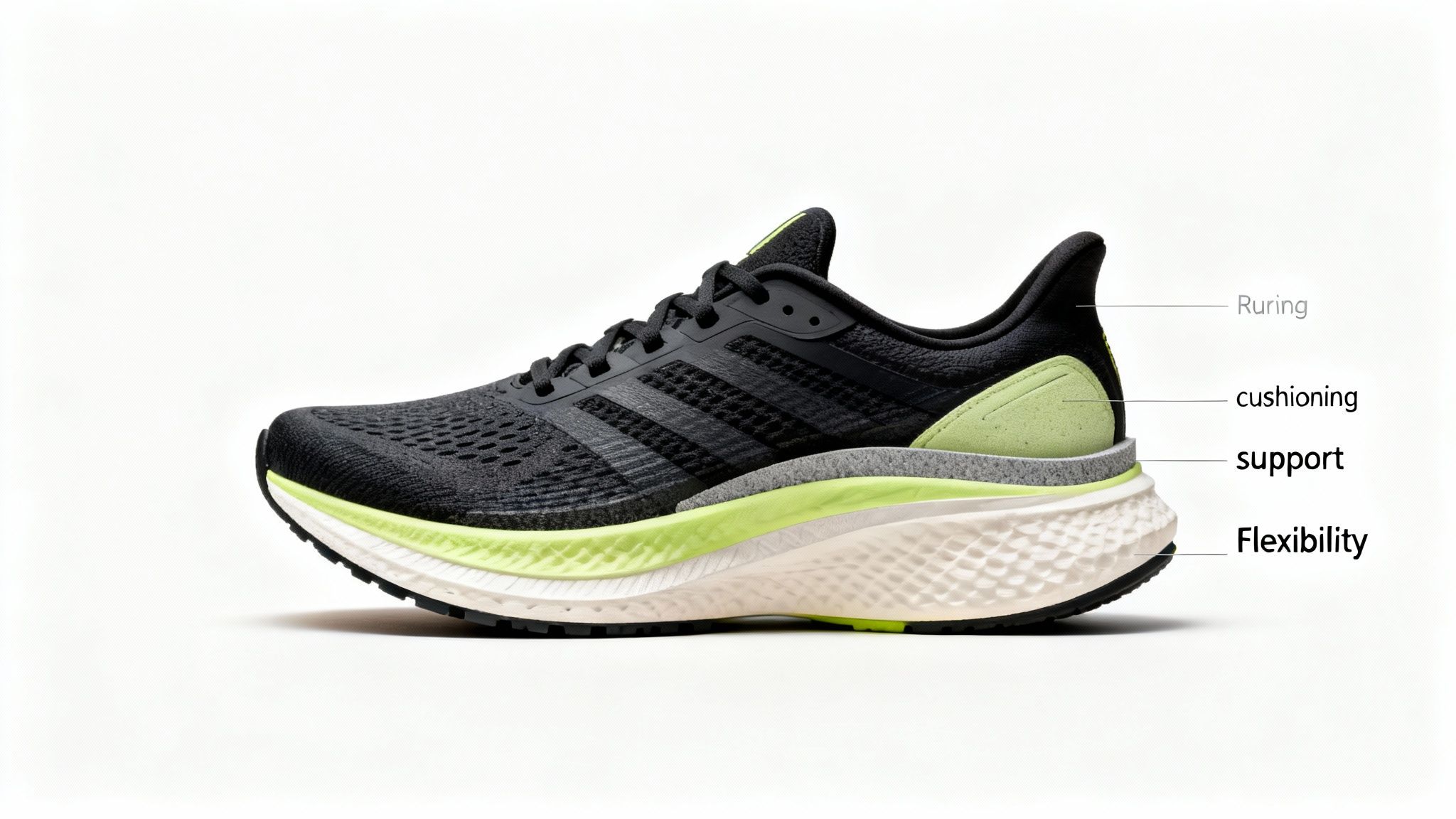Best Running Shoes for High Arches
- Flourish Everyday Health And Fitness

- Oct 19
- 10 min read
Updated: Oct 23
If you're a runner with high arches, finding the right shoe means looking for two things: maximum cushioning and a solid, neutral support system. Top contenders like the Brooks Ghost, ASICS Gel-Nimbus, and HOKA Clifton consistently deliver the shock absorption and flexible design needed to protect your feet and joints, mile after mile.

Your Guide to Finding Relief and Performance
Running with high arches, a condition known as pes cavus, makes your foot less effective at absorbing impact, which can lead to aches and injuries. This guide will show you how the right pair of shoes can turn a painful run into a powerful one.
Think of your foot as a natural spring. A high arch makes that spring stiffer, so instead of absorbing force, more of it travels up your legs. That's why your average running shoe often doesn't cut it.
The right footwear helps distribute pressure evenly, absorbs impact, and reduces strain on your feet, ankles, and joints. It's not just about comfort, it's about injury prevention and performance.
In this guide, I will help you find that perfect pair, we'll cover the essentials without complicated jargon. For a broader look at shoe selection, you can also check out our instructions on how to choose running shoes in our expert guide.
Here's what we'll be diving into:
Understanding High Arches: Why they need special attention in running shoes.
Essential Shoe Features: A look at cushioning, neutral support, and flexibility.
Top Shoe Reviews: In depth reviews for men and women with high arches.
Injury Prevention & Health Information: Stretches and exercises to support your feet.
Well-Being Trends & Methods: A comparison of insoles and orthotics for foot health.
Why High Arches Change the Way You Run
If you have high arches, known medically as pes cavus, it fundamentally alters how your body handles running. A typical foot acts like a spring, flexing to absorb impact. A high arch, however, makes that spring much stiffer.
This rigidity means your foot is poor at shock absorption. Instead of spreading impact harmlessly, the force shoots up your body, into your ankles, shins, and knees. This is why finding the best running shoes for high arches is about protecting your entire body from repetitive stress.
The Impact of Supination on Your Stride
The stiffness of a high arch often leads to a running pattern called supination, where your foot rolls outward on impact. Instead of your weight rolling evenly, it stays on the outer edge of your foot. This uneven weight distribution can throw off your balance and increase the risk of specific injuries.
Common issues tied to high arches and supination include:
Plantar Fasciitis: Sharp heel pain from inflammation of the tissue along the bottom of your foot.
Shin Splints: Nagging pain along the inside of your shinbone.
Stress Fractures: Tiny cracks in the bones of your feet and lower legs from repetitive force.
Ankle Sprains: A greater chance of rolling your ankle due to instability.
Cushioning: Your First Line of Defense
Since your foot’s shock absorption is compromised, shoe cushioning becomes your primary defense.
For a runner with high arches, modern shoe cushioning acts as an external shock absorber. It dissipates impact where you land, preventing jarring force from traveling up your legs and causing overuse injuries.
This simple infographic illustrates how a high arch affects shock absorption.

The stiff nature of a high arch leads to poor shock absorption, putting more stress on the rest of your body. This need for specialized footwear is driving growth in the athletic shoe market. The global market for running shoes is expected to climb to $16.37 billion in 2025 from $15.22 billion in 2023, showing a growing demand for shoe technology that addresses specific foot types. You can find more details in these running shoe market statistics.
Understanding this connection helps you search for shoes with the generous, neutral cushioning needed for safer, more enjoyable runs.

Decoding Shoe Features for High Arch Support
For those with high arches, you can cut through the marketing noise by focusing on three non-negotiable features: cushioning, support, and flexibility. These pillars form the foundation of a shoe that will protect your feet and smooth out every run.
Essential Shoe Features for High Arches
Feature | Why It Matters for High Arches | What to Look For |
|---|---|---|
Generous Cushioning | High arches are poor shock absorbers, so cushioning must do that job to prevent joint stress. | Shoes with a thick, responsive midsole from foams like EVA or TPU. Look for "plush," "soft," or "max cushion" descriptions. |
Neutral Support | Runners with high arches often supinate (roll outward). Neutral shoes guide the foot's natural motion without over-correction. | A structured heel counter, a well-fitting upper, and a stable, slightly wider base. Avoid "stability" or "motion control" shoes. |
Forefoot Flexibility | A rigid foot needs a flexible shoe to allow for a natural push-off and a smooth stride. | A shoe that bends easily at the ball of the foot. Test it by holding the heel and pressing the toe upward. |
This table is your cheat sheet. Keep these three things in mind, and you'll be on your way to picking a shoe that works with your foot.
Cushioning Explained
For a high arched foot, cushioning is your primary defense. It acts as an external shock absorber, eating up the jarring force of each footstrike. The magic happens in the midsole, the foam layer between the insole and outsole. Modern shoes use advanced foam compounds:
EVA (Ethylene Vinyl Acetate): Lightweight and soft, providing fantastic shock absorption and a plush feel.
TPU (Thermoplastic Polyurethane): Heavier but more durable and resilient, offering excellent energy return.
For high arches, a generous stack of soft, responsive foam is the goal, reducing impact stress on the heel and ball of the foot.
The True Meaning of Support
For high arches, support does not mean a hard insert pushing into your arch. That can create painful pressure points. Instead, you need a neutral shoe with a solid, structured design that guides your foot's natural path.
A supportive shoe for high arches acts like a gentle guide rail, not a corrective brace. It encourages a smooth stride by providing a stable platform and securing the heel.
Look for a snug heel counter that locks your foot in place and a slightly wider base for a stable landing. This combination helps prevent ankle rolling without interfering with your natural biomechanics.
Flexibility for a Natural Stride
Even with great cushioning and support, a shoe must be flexible. Rigid feet need a shoe with good forefoot flexibility for a smooth heel-to-toe transition. This allows your foot to push off the ground powerfully. Look for a shoe that bends easily at the ball of your foot, mirroring its natural flex point for a fluid stride.
Top Running Shoe Reviews for High Arches
Best running shoes for high arches are some of the best running shoe models in the fitness industry, focusing on cushioning and neutral support. Each review gets straight to the point: how good is the midsole? Is it stable? What does the ride feel like?
Brooks Ghost (Men's & Women's)
The Brooks Ghost is a legend in the neutral running world, known for its balanced, reliable cushioning. The DNA LOFT v2 midsole is fantastic at absorbing shock, critical when your arches can't do it alone. The Ghost provides a smooth, consistent ride that just works. The secure fit through the midfoot and heel prevents instability that can lead to ankle issues.
Pros: Balanced cushioning for daily miles, smooth heel-to-toe transition, durable outsole.
Cons: Less "springy" than some newer max-cushion trainers.
Hoka Clifton(Men's & Women's)
When you think "maximum cushioning," you think Hoka. The Hoka Clifton offers a plush, highly protective ride that's ideal for high arches. Its thick EVA foam feels like running on pillows, significantly reducing stress on your heels and forefeet. Despite the cushion, the Clifton is surprisingly light. Its early stage Meta Rocker design also helps roll you forward, promoting an efficient stride.
The Hoka Clifton packs in maximum cushioning without the weight, directly addressing the biggest need for high-arched runners: top-tier shock absorption in a lightweight shoe.
ASICS offers two excellent options. The ASICS GEL-Nimbus is a classic, famous for luxurious comfort and GEL technology for targeted shock absorption in the heel and forefoot. It prioritizes a soft, protective ride.
The ASICS Novablast series is all about an energetic, bouncy experience. The Novablast 5 is a phenomenal shoe for high arches, with a massive stack height and exceptionally soft foam for an unbelievably cushioned ride. You can read more in this detailed Novablast 5 analysis.
GEL-Nimbus: Best for runners wanting a soft, protective feel.
Novablast: Perfect for those who crave max cushioning with a lively, responsive bounce.
New Balance Fresh Foam X 1080 (Men's & Women's)
The New Balance Fresh Foam X 1080 is a versatile, elite neutral trainer. It hits the sweet spot between soft and responsive. The Fresh Foam X midsole is pillowy enough for long runs but has enough energy return to avoid a sinking feeling. This is a do-it-all shoe for daily miles, recovery jogs, and even some tempo work. Its engineered upper provides a secure, stretchy fit.
Comparison of Top Running Shoes for High Arches
The "best" shoe comes down to what feels right for your foot and running style. This table breaks down the key details to help you compare these excellent options.
Shoe Model | Cushioning Level (1-5) | Best For | Key Feature |
|---|---|---|---|
Brooks Ghost | 4 | Daily training, reliability | Balanced DNA LOFT cushioning |
Hoka Clifton | 5 | Long distances, recovery runs | Maximum cushioning, lightweight feel |
ASICS Novablast | 5 | Energetic, bouncy long runs | High stack height, soft foam |
New Balance 1080 | 4.5 | Versatile, all-around training | Soft yet responsive Fresh Foam X |
The right running shoes are your first line of defense, but a complete approach is needed to stay healthy. Supporting your feet involves actively working on the strength and flexibility of the muscles that support your foot structure. Pairing the right shoes with a consistent routine of stretches and exercises creates a powerful support system.
Targeted Stretches for High Arches
High arches often lead to tightness in the lower legs and feet. A few simple, targeted stretches can make a world of difference.
Plantar Fascia Stretch: Sit and cross one leg over the other knee. Gently pull your big toe back toward your shin until you feel a stretch in your arch. Hold for 15-20 seconds; repeat three times on each foot.
Calf Stretch: Stand facing a wall. Step one foot back, keeping the leg straight and heel flat on the floor. Lean forward until you feel a stretch in your calf. Hold for 30 seconds on each side.
Building a Stronger Foundation
Strengthening the small muscles in the feet and ankles is a game-changer for stability, especially for supinators.
"A well-cushioned shoe protects the foot from external forces, but strengthening the foot's intrinsic muscles provides internal stability. Combining both is the key to creating a truly resilient runner."
Try these simple exercises:
Towel Curls: Sitting, use your toes to scrunch and pull a small towel on the floor toward you.
Marble Pickups: Use your toes to pick up marbles from the floor and drop them into a bowl.
Calf Raises: Stand and slowly raise your heels off the ground. Pause, then lower back down.
For more strategies, check out these top tips for safe running and injury prevention.
Well-Being Trends: The Great Insole Debate
If your shoes don't feel quite right, insoles might be the answer. But should you choose over-the-counter inserts or custom orthotics?
Over-the-Counter (OTC) Insoles: Pre-made inserts offering general cushioning and mild support. A good starting point if you need a bit more arch contour or shock absorption.
Custom Orthotics: Medically prescribed devices custom-molded to your feet. They correct specific biomechanical issues and are recommended for runners with persistent pain.
For many, a great neutral shoe is sufficient. If you still want more support, try an OTC insole. Custom orthotics are typically the final option for serious, targeted correction.

Your Next Steps to Comfortable Running
You now have the knowledge to pick your next running shoes with confidence. Finding the best running shoes for high arches is an investment in your health and enjoyment of every mile.
Remember the core ideas: look for generous cushioning, stick with a neutral support system, and never compromise on a secure, comfortable fit.
Focusing on these key elements takes the guesswork out of shoe shopping. You can now see past the marketing hype and zero in on the features that actually matter for your feet.
Even the perfect shoe won't last forever. To ensure you're always protected, it's crucial to know when it’s time for a new pair. Learn more in our guide on **how often to replace running shoes**.
You understand your feet and the shoe technology built to support them. Lace up and feel the difference.
Happy running.
Got Questions? We've Got Answers
Do I Really Need Special Insoles or Orthotics?
Not always. Many of the best running shoes for high arches today have incredible built-in cushioning. Advanced foam in modern neutral shoes often provides all the shock absorption you need. If you have a great pair of shoes but still experience persistent pain, then consider insoles. Try a well-cushioned, neutral shoe first.
Should I Go for a Neutral or a Stability Shoe?
Most runners with high arches supinate (foot rolls outward). Because of this, a neutral shoe is almost always the right choice. They are built with ample cushioning and flexibility, letting your foot move naturally. Stability shoes are designed to stop the foot from rolling inward (overpronation) and can feel too rigid for a high-arched foot.
How Often Should I Replace My Running Shoes?
A good rule of thumb is every 300-500 miles. This is especially important for high arches. The midsole foam is your primary defense against impact, and it breaks down over time. Running on worn-out cushioning increases stress on your joints and can lead to overuse injuries.
References
Buldt, A. K., & Menz, H. B. (2018). Foot posture and injury risk in runners: A systematic review. Journal of Foot and Ankle Research, 11(1). https://doi.org/10.1186/s13047-018-0299-7
Market.us. (2023). Running Shoes Market Research Report. Retrieved from https://market.us/report/running-shoes-market/
DiGiovanni, B. F., & Partal, G. (2003). The role of custom foot orthotics in the management of foot pain. The Journal of the American Academy of Orthopaedic Surgeons, 11(6), 411-417.
Here at Flourish-Everyday, we're your go-to source for expert reviews and health information you can trust. We're here to give you everything you need to support and empower your journey to a healthier, happier you. Find your next perfect pair of running shoes today




Comments